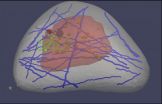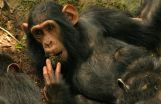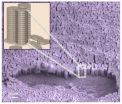(Press-News.org) Next to lung cancer, breast cancer is the leading cause of cancer death in women, according to the American Cancer Society. That's why so many medical professionals encourage women to get mammograms, even though the tests are imperfect at best: only a minority of suspicious mammograms actually leads to a cancer diagnosis.
That results in lots of needless worry for women and their families—not to mention the time, discomfort and expense of additional tests, including ultrasounds and biopsies.
Recently, a different type of test, ultrasound elastography, has been used to pinpoint possible tumors throughout the body, including in the breast. "It uses imaging to measure the stiffness of tissue, and cancer tissues are stiff," says Jingfeng Jiang, a biomedical engineer at Michigan Technological University. Those images can be breathtakingly clear: Jiang shows one elastogram in which the tumor is as different from normal breast tissue as a yolk is from the white in a fried egg. However, not all images are that precise.
"Depending on who does the reading, the accuracy can vary from 95 percent to 40 percent," he said. "Forty percent is very bad—you get 50 percent when you toss a coin. In part, the problem is that ultrasound elastography is a new modality, and people don't know much about it."
Ultrasound elastography could be an excellent screening tool for women who have suspicious mammograms, but only if the results are properly interpreted. Jiang, who helped develop ultrasound elastography when he was a postdoctoral researcher at the University of Wisconsin–Madison, reasoned that clinicians might improve their accuracy if they could practice more. So he and his colleagues set about to build a virtual breast.
Like a simulator used to train fledgling surgeons, their virtual breast—a 3D, computer-generated "phantom"—would let medical professionals practice in the safety of the lab. It was developed using data from the Visible Human Project, which gathered thousands of cross-sectional photos from a female cadaver. Thus, it mimics the intricacy of the real thing, incorporating a variety of tissue types and anatomical structures, such as ligaments and milk ducts.
Clinicians can practice looking for cancer by applying virtual ultrasound elastography to the virtual breast and then evaluating the resulting images. Jiang hopes that eventually the lab software will be available to anyone who needs the training.
Jiang's team, including Associate Professor Yu Wang and undergraduate Emily Helminen, both of Michigan Tech, presented a poster on their work, "A Virtual Breast Elastography Phantom Lab Using Open Source Software," at the IEEE Ultrasonics Symposium, held Sept. 3-6 in Chicago.
INFORMATION:
Their work is supported by $452,780 from the National Institutes of Health through the National Cancer Institute. The grant number is R15CA179409-01A1.
'Virtual breast' could improve cancer detection
2014-09-30
ELSE PRESS RELEASES FROM THIS DATE:
Rehospitalization in younger patients
2014-09-30
Older adults often are readmitted after hospitalization for heart failure, pneumonia, and acute myocardial infarction, a significant issue that has caused Medicare to target hospitals with high 30-day readmission rates for financial penalties. Older adults are also often admitted for reasons other than the original hospitalization. This vulnerability to readmission has been referred to as "post-hospital syndrome." However, whether younger patients also experience a similar pattern of readmission has not been well studied.
In a large cohort study, Isuru Ranasinghe and ...
Diuretics in proton pump inhibitor-associated hypomagnesemia
2014-09-30
Proton pump inhibitor (PPI) therapy is associated with hospitalization for hypomagnesemia, particularly among patients also receiving diuretics, according to research published this week in PLOS Medicine. The study, conducted by David Juurlink of the University of Toronto and colleagues, suggests that physicians reconsider long-term PPI therapy for patients with a diagnosis of hypomagnesemia or concurrent use of diuretics.
Roughly 145 million prescriptions for PPI are dispensed in the United States annually for acid-related disorders such as dyspepsia and gastroesophageal ...
At dusk and dawn: Scientists pinpoint biological clock's synchronicity
2014-09-30
Scientists have uncovered how pacemaker neurons are synchronized at dusk and dawn in order to maintain the proper functioning of their biological clocks. Their findings, which appear in the journal PLOS Biology, enhance our understanding of how sleep-wake cycles are regulated and offer promise for addressing related afflictions.
"We've known for some time that the time-keeping of our biological clocks is a complex enterprise," says New York University's Justin Blau, a professor of biology and neural science and one of the study's co-authors. "But our results offer new ...
How dinosaur arms turned into bird wings
2014-09-30
Although we now appreciate that birds evolved from a branch of the dinosaur family tree, a crucial adaptation for flight has continued to puzzle evolutionary biologists. During the millions of years that elapsed, wrists went from straight to bent and hyperflexible, allowing birds to fold their wings neatly against their bodies when not flying.
How this happened has been the subject of much debate, with substantial disagreement between developmental biologists, who study how the wings of modern birds develop in the growing embryo, and palaeontologists who study the bones ...
Study shows how chimpanzees share skills
2014-09-30
Evidence of new behaviour being adopted and transmitted socially from one individual to another within a wild chimpanzee community is publishing on September 30 in the open access journal PLOS Biology. This is the first instance of social learning recorded in the wild.
Scientists from University of St Andrews, University of Neuchâtel, Anglia Ruskin University, and Université du Quebec studied the spread of two novel tool-use behaviours among the Sonso chimpanzee community living in Uganda's Budongo Forest. Dr Catherine Hobaiter, Lecturer in Psychology at the University ...
Boys and girls who've had a traumatic brain injury differ in rates of harmful behavior
2014-09-30
TORONTO, Sept. 30, 2014 – Teenagers who said they had a traumatic brain injury in their lifetime, especially girls, also reported significantly higher rates of harmful behavior, according to new research.
The study looked at 13 harmful health behaviours –such as contemplating suicide, smoking marijuana or binge drinking– among 9,288 Ontario students between Grades 7 and 12.
"Both boys and girls were more likely to engage in a variety of harmful behaviours if they reported a history of TBI, but girls engaged in all 13 harmful behaviours we looked for, whereas boys were ...
Blades of grass inspire advance in organic solar cells
2014-09-30
AMHERST, Mass. – Using a bio-mimicking analog of one of nature's most efficient light-harvesting structures, blades of grass, an international research team led by Alejandro Briseno of the University of Massachusetts Amherst has taken a major step in developing long-sought polymer architecture to boost power-conversion efficiency of light to electricity for use in electronic devices.
Briseno, with colleagues and graduate students at UMass Amherst and others at Stanford University and Dresden University of Technology, Germany, report in the current issue of Nano Letters ...
Comprehensive Study of allergic deaths in US finds medications are main culprit
2014-09-30
September 30, 2014—(BRONX, NY)—Medications are the leading cause of allergy-related sudden deaths in the U.S., according to an analysis of death certificates from 1999 to 2010, conducted by researchers at Montefiore Medical Center and Albert Einstein College of Medicine of Yeshiva University. The study, published online today in the Journal of Allergy and Clinical Immunology, also found that the risk of fatal drug-induced allergic reactions was particularly high among older people and African-Americans and that such deaths increased significantly in the U.S. in recent ...
The cultural side of science communication
2014-09-30
EVANSTON, Ill. --- Do we think of nature as something that we enjoy when we visit a national park and something we need to "preserve?" Or do we think of ourselves as a part of nature? A bird's nest is a part of nature, but what about a house?
The answers to these questions reflect different cultural orientations. They are also reflected in our actions, our speech and in cultural artifacts.
A new Northwestern University study, in partnership with the University of Washington, the American Indian Center of Chicago and the Menominee tribe of Wisconsin, focuses on science ...
Rating the planet's oceans
2014-09-30
The most comprehensive assessment conducted by the Ocean Health Index rates the Earth's oceans at 67 out of 100 in overall health. In addition, for the first time, the report assessed the Antarctic and the 15 ocean regions beyond national jurisdiction (high-seas areas) — all critical regions for maintaining a healthy climate, safeguarding biodiversity and providing sustainable food sources.
In the third annual update of the index, a partnership led by scientists from UC Santa Barbara's National Center for Ecological Analysis and Synthesis (NCEAS) and Conservation International ...



